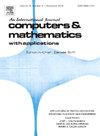A posteriori error estimates for the DD+L2 jumps method on the neutron diffusion equations
IF 2.5
2区 数学
Q1 MATHEMATICS, APPLIED
引用次数: 0
Abstract
We analyze a posteriori error estimates for the discretization of the neutron diffusion equations with a Domain Decomposition Method, the so-called DD+ jumps method. We provide guaranteed and locally efficient estimators on a base block equation, the one-group neutron diffusion equation. Classically, one introduces a Lagrange multiplier to account for the jumps on the interface. This Lagrange multiplier is used for the reconstruction of the physical variables. Remarkably, no reconstruction of the Lagrange multiplier is needed to achieve the optimal a posteriori estimates.
中子扩散方程DD+L2跳变方法的后验误差估计
本文用域分解方法,即DD+L2跳变法,分析了中子扩散方程离散化的后验误差估计。我们对基块方程,即单群中子扩散方程,给出了保证的局部有效估计。经典地,人们引入拉格朗日乘数来解释界面上的跳跃。这个拉格朗日乘子用于物理变量的重建。值得注意的是,不需要重建拉格朗日乘子来获得最优的后验估计。
本文章由计算机程序翻译,如有差异,请以英文原文为准。
求助全文
约1分钟内获得全文
求助全文
来源期刊

Computers & Mathematics with Applications
工程技术-计算机:跨学科应用
CiteScore
5.10
自引率
10.30%
发文量
396
审稿时长
9.9 weeks
期刊介绍:
Computers & Mathematics with Applications provides a medium of exchange for those engaged in fields contributing to building successful simulations for science and engineering using Partial Differential Equations (PDEs).
 求助内容:
求助内容: 应助结果提醒方式:
应助结果提醒方式:


